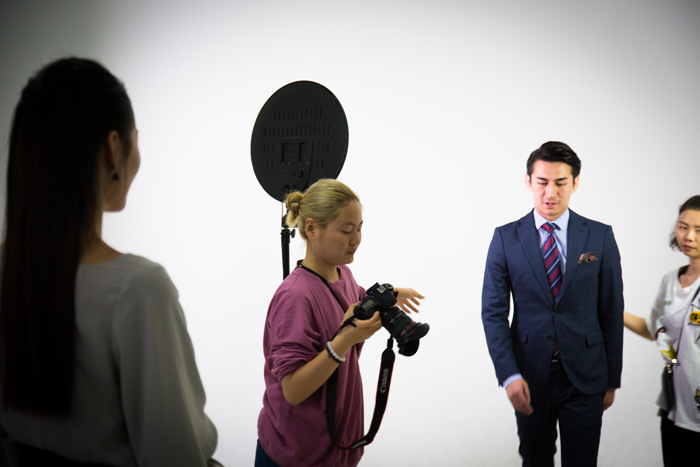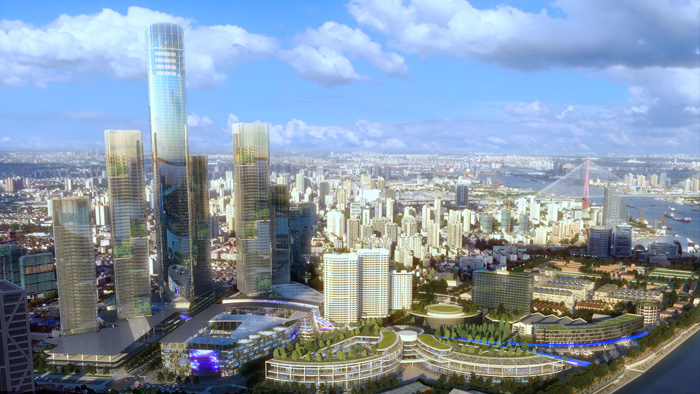Visualisation studio Neoscape has used V-Ray for 3ds Max to create a video that takes visitors on a striking journey around a planned development for Shanghai’s Yangpu riverfront district
The goal of the Yangpu Ba Dai Tou plan is to transform the Yangpu riverfront from an aging industrial area of Shanghai to a vibrant residential and commercial district. The mixed-use construction will combine offices, hotels, retail spaces, parks and repurposed historical structures to create an environment that is both modern and pedestrian-friendly.
To convey this idea, architects at John Portman & Associates needed a powerful visual presentation that would walk visitors through key site components, from the Pearl Necklace, a pedestrian circle, to the Dragon Spine, the site’s retail and connector zone. They turned to visualisation studio Neoscape to create a video that showcased the development’s highlights.

“When we put together the creative treatment, we knew that we didn’t want it to be a simple programmatic study,” says Carlos Cristerna, principal and director of visualisation at Neoscape. “We wanted to create a more interesting visual style without overcomplicating the production, so we devised a more abstract approach to the story.”
Dragon tale
Since the Dragon Spine was already part of the architect’s design, Neoscape used it as a narrative device, taking the audience through Shanghai, up the river, and back to the site. This potent cultural symbol allowed the firm to reference both the history of Yangpu, and the original point of entry into Asia. Colourful graphics inspired by long exposures, Chinese paintings, and films like Tron provided the final touch, helping Neoscape incorporate the traditional dragon from Chinese New Year, with a few modern flourishes.

While 3D animation played an essential role in the production, Neoscape also saw an opportunity to combine its visualisations with live video, shot on location in Shanghai. The brief called for multiple aspect ratios, meaning that the final video would live both online (16:9) and out in the world (19:4), primarily on a 55’ x 11’ projection screen in Yangpu Ba Dai Tou’s marketing centre.
“We had to be very deliberate in our selection of camera moves and framing, so whatever we shot would work for multiple ratios,” Cristerna explains. “You’ll notice that, in the video, most of the cameras pan from bottom to top, top to bottom, or use a subtle move that reveals the subject. This was done so that no matter what ratio you are viewing it on, you’ll be able to see the totality of the shot, as it was intended. It was kind of like a moving Ken Burns approach.”
New depths
The next challenge was producing a version with stereoscopic depth. A common way to produce 3D movies, stereoscopy creates the illusion of depth in images. It’s a useful trick, but it’s also a time-consuming process that doubles the rendering load for visualisation projects, because it creates a need for an image for both the right and left eyes.
With 4K visual effects already in production and only 20 weeks to deliver an 8-minute film, twice the render load meant that Neoscape would have to put its rendering software into overdrive. The team put its faith in V-Ray for 3ds Max, as they felt it could be trusted for both quality and speed.
“At one point on the project, we calculated that we would need 17.5 days of nonstop rendering for the 3D work alone; one computer would have taken 1,010 days, and this was when we only had 12 days left!” says Cristerna. “Luckily, because of V-Ray, our average times were very good, and most frames rendered a lot faster than we anticipated.”
Excluding the neon sequence, 32,500 frames were rendered by Neoscape. The 4K production, however, continued to loom over the project. Because client reviews were conducted live via video conference and using two translators between Boston, Atlanta and Shanghai, video reviews couldn’t be done in 4K or stereo 3D. That resulted in a big rush at the end of the production.
“One of our biggest challenges was that you can’t see the film in stereo while you’re working on it, so we needed to adjust our pipeline to review those shots,” added Cristerna. “After the stereo reviews, we realised that we had to re-render a few shots with wider interocular distances to increase the depth, so we could use them to greater effect as a device that impacts viewers’ emotions. We adjusted about half of our cameras that day.”

Pay-off time
The hard work paid off. Instead of a linear walkthrough, Neoscape created an abstract visual story in which viewers teleport around the development, taking in new sights augmented by time lapses, animations and video footage depicting residents and visitors engaging with all aspects of the area – commercial, residential and public. As cars cruise and buildings shimmer, the “vital and vibrant” look that its creators were aiming for quickly takes form.
Today, the film is running at Yangpu Ba Dai Tou’s marketing centre in 4K stereoscopic 3D. Ironically, Cristerna is the only Neoscape team member who has actually watched it on location.
“When we wrapped, I hand-delivered the film to Jack Portman in person, and since his client was there, we had a private screening. After the lights came on, one thing was clear: Jack was happy, his client was happy, and so were we. It was a good feeling,” he says.
■ neoscape.com ■ chaosgroup.com
If you enjoyed this article, subscribe to AEC Magazine for FREE






